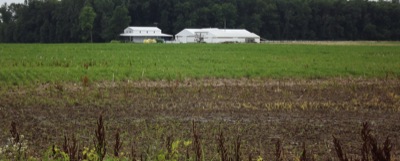Friday, July 10th, 2015
Rain washing away this year's crop profits
Losses for local farmers expected to range from 15 to 40 percent
By Shelley Grieshop

Photo by Shelley Grieshop/The Daily Standard
A portion of a field along state Route 703 near Montezuma is barren Thursday after recent flooding damaged and washed away soybean plants. Record-breaking rainfall in June and ongoing wet weather are expected to reduce profits this year for area farmers.
Record rainfall has damaged up to 40 percent of some area crops and created one of the worst growing seasons in local history.
"In my lifetime ... when it comes to water damage, this is one of the worst I've seen," said Coldwater area farmer Dusty Uhlenhake, who also sells products for Stewart Seeds.
Crop-loss amounts vary across the Grand Lake area, according to local agriculture officials. Fields not tiled well or located near waterways have suffered major flooding and some remain submerged, Uhlenhake said.
"Most of the crops planted in late April, early May have a good root system and are looking good," he said. "Those planted later, not so good."
Nearly 13 inches of rain was recorded in the Celina area during the month of June, breaking the 1958 record of 8.8 inches. The average rainfall for June is 3.86 inches.
Local weather forecaster Dennis Howick measured another 2.65 inches of rain since Tuesday with more showers possible in coming days.
Mercer County farmers have lost 15-20 percent of their corn, estimated county Farm Services Agency executive director Chris Gibbs.
"Along the Beaver (Creek), Wabash (River), St. Marys (River), in those low spots many crops have been destroyed," he said. "If farmers have their whole crop in those areas, it's devastating. There's no recovery. I hope they have crop insurance."
Reimbursement through crop insurance is the only action farmers can take to ease the revenue loss because a disaster declaration hasn't been made, Gibbs said.
He is more optimistic about soybeans, which "don't like cold, wet feet" but are more resilient than corn.
"Some beans look lethargic right now but they're patient. They have the ability to wait (for drier weather)," he said. "I don't want to speculate on soybean losses. The jury's still out."
Due to excessive muddy soil, many farmers were unable to get into their fields for about 35 consecutive days, Gibbs said. That means no nitrogen or herbicide applications were completed to help salvage damaged plants, he added.
"There's just been no opportunity to do field work. It's so saturated, no sunshine and overcast," Gibbs said. "I can't remember a time when there was just no movement at all like this."
Auglaize County Farm Service Agency Executive Director Anita Green estimated corn yield losses at 30 percent and soybeans at 40 percent or higher in the neighboring county.
"What's unique and notable about this year is it's (damage) widespread. In the past, we've had isolated spots," Green said.
Profit margins for some farmers are tight and this year's harvest - coupled with higher costs and lower commodity prices - could have a big impact, she explained.
"We have it bad but there are areas that are worse," she said, adding northern Ohio counties such as Paulding, Hardin and Logan experienced more severe flooding. "Some of those farmers never got their fields planted."
Local farmers scrambled over the Fourth of July weekend to get wheat harvested, she said. Due to the wet fields, only about 20 percent was harvested in Auglaize County, Green said.
"We typically have 70 percent in by this time," she said.
Officials said grain quality related to the excess moisture also is an issue many fear.
"We're hearing about lots of things like head scab, vomitoxin (fungus) and molds. They're testing for vomitoxin but I haven't seen results yet," Green said.
Uhlenhake said corn is vulnerable to grey leaf spot and northern corn leaf blight. He recommends fungicide applications.
Uhlenhake said the crop situation isn't looking good but he's optimistic Mother Nature will ultimately cooperate with sunshine and warmer temperatures.
"I'm not giving up hope yet," he said.

Photo by Shelley Grieshop/The Daily Standard
Small cornstalks stand in water along Cassella-Montezuma Road. Record-breaking rainfall in June and ongoing wet weather are expected to reduce profits this year for area farmers.


